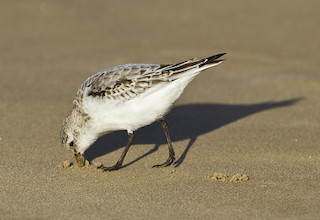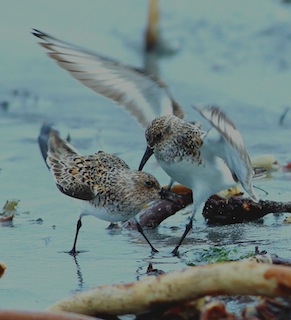 The south-west is supposedly not such a good place to look for Sanderlings on migration, but a few turn up each year. Predannack is one good place to look.
The south-west is supposedly not such a good place to look for Sanderlings on migration, but a few turn up each year. Predannack is one good place to look.
Photo: © Natural England/Allan Drewitt
Scientific name: Calidris alba
Conservation status: UK Birds of Conservation Concern, Green; IUCN Red List, Least Concern
What to look for:
- Colouring and appearance: Black beak and legs, white underparts. Reddish-brown above in breeding season; paler at other times of year. Females are slightly larger.
- Size: Length 20 cm, wingspan 42 cm.
- Where: Coastline of UK, other than in breeding season.
- Call: Chirping flight call.
 The Sanderling, a wading bird of estuaries and sandy beaches, is definitely a contender for the quirkiest bird of the seashore. It doesn’t breed in the UK – it breeds much further north in the tundra of the high Arctic – but look out for this plump wader in winter and on migration in the spring and autumn.
The Sanderling, a wading bird of estuaries and sandy beaches, is definitely a contender for the quirkiest bird of the seashore. It doesn’t breed in the UK – it breeds much further north in the tundra of the high Arctic – but look out for this plump wader in winter and on migration in the spring and autumn.
If you are lucky enough to spot a group of Sanderlings feeding on the seashore, then you can enjoy watching them dashing away from the incoming waves. All wading birds found in Britain have a hind toe – that is, apart from the Sanderling, which moves like an automaton as it dashes away from the water. The clockwork dance of Sanderlings as they forage and seek to dominate each other along a sandy beach is as entertaining as ‘Strictly Come Dancing’ any day.
 Did you know…?
Did you know…?
…The species name alba (the Latin for ‘white’) refers to the pale winter plumage.
More information and references:
Svensson, L., Mullarney, K., Zetterstrom, D.,1986. Collins Bird Guide, second edition (translated by Christie, D., Svensson, L.). HarperCollins, London.
Published: August 2015
Author: Amanda Scott
Photos: Upper: © Natural England/Allan Drewitt; lower (squabbling Sanderlings on Shetland in summer plumage): Amanda Scott
